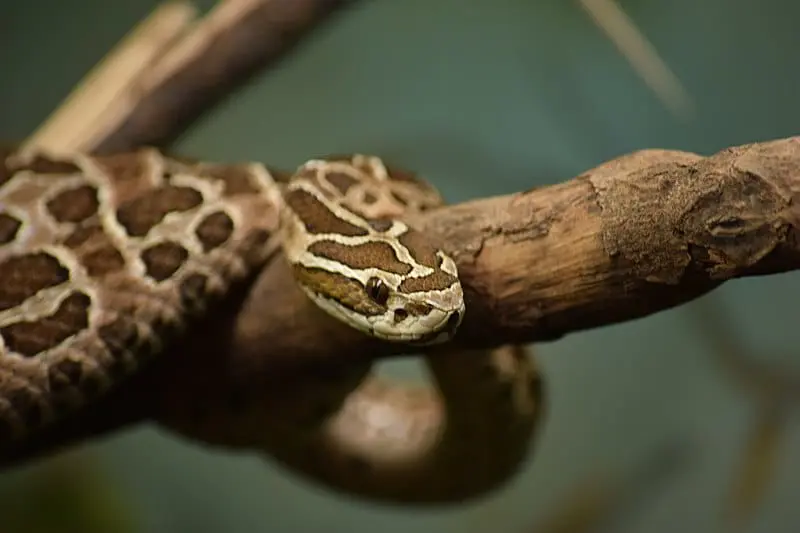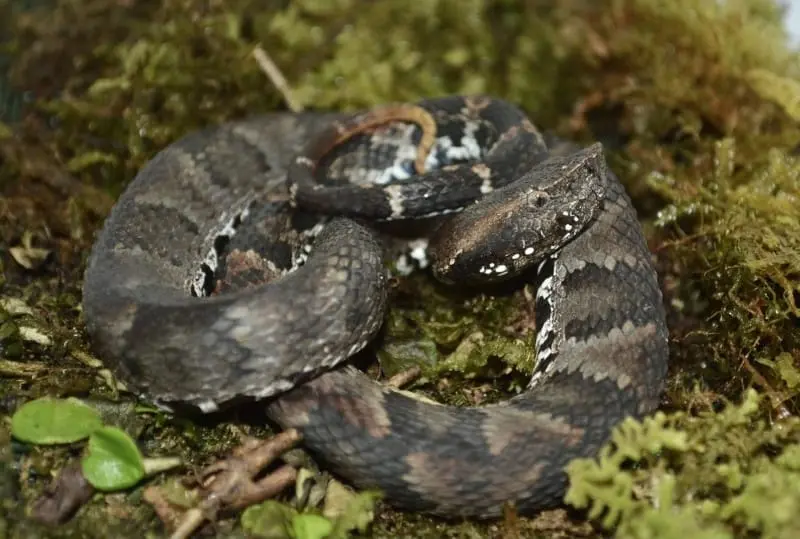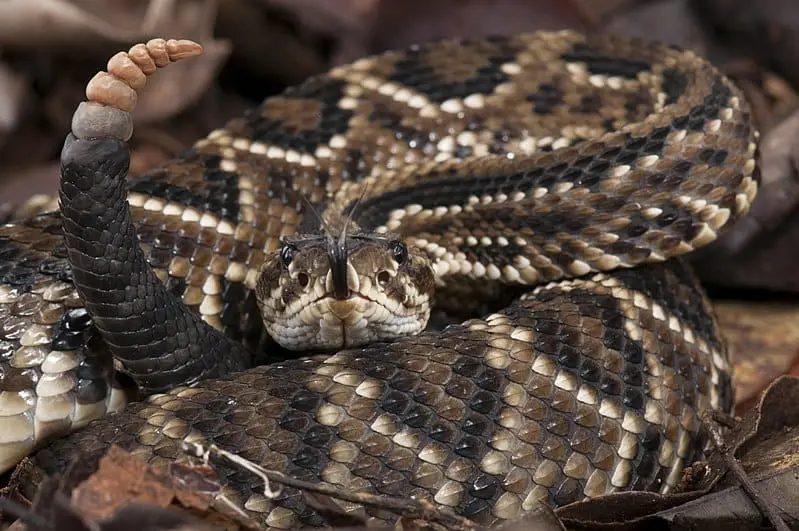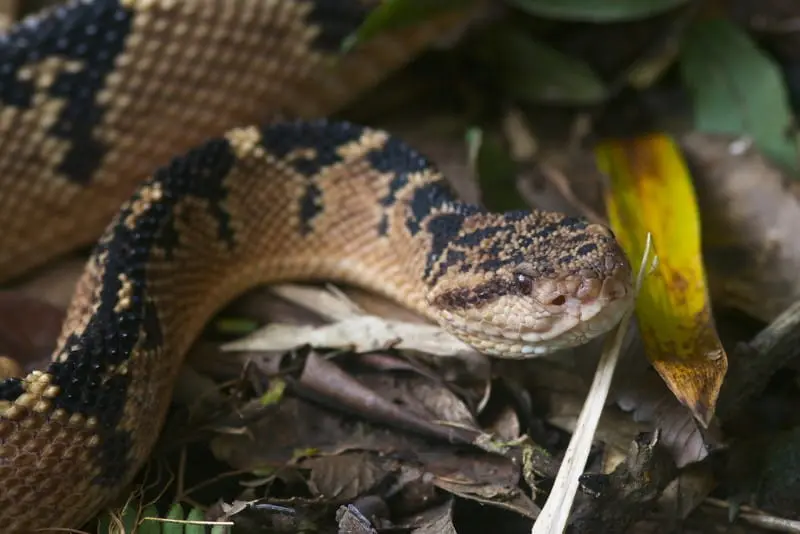Brazilian Vipers
Vipers are a family of venomous snakes found in most parts of the world. They are usually identified by the slit shape of their pupils, which open in darkness and close in light; their long, articulated fangs, which allow them to penetrate and inject venom; the presence of keeled scales instead of flat ones; and the triangular shape of their head.
However, such rulers should not be applied to Brazilian vipers, as there are many exceptions.1
Nevertheless, other characteristics can be noted to identify them, such as the presence of sensory organs located between the nostrils eyes called “heat-sensing pits”. These organs favor the detection of warm-blooded animals, allowing some species to be able to detect temperature variations of up to 0.003 °C1 2 — creating heat maps of their surroundings and easily finding their prey.
Of the four subfamilies currently recognized, only one is found in Brazil, the Crotalinae — of which all rattlesnakes, bushmasters and jararacas are part. However, the taxonomy and systematics of this group are poorly resolved, so new species are described while some are synonymized.
Many species are nocturnal and terrestrial, but it is possible to find them during the day in bushes and small trees, especially young individuals. The Bothrops insulari, in particular, spends most of its time in trees because of its habit of feeding exclusively on birds.
Scales coloration, level of toxicity, and behavior can also vary greatly by genus and species.
Bothrops

This family includes cotiaras, urutus, lanceheads, jararacas and jararacussus that ranging from 70 cm (2 ft) to 2 m (6,5 ft) long.
Snakes of the Bothrops family are found throughout Brazil, but while some species are found in several states, others are restricted to specific regions. The lancehead B. sazimai, discovered in 2016, for example, is found only on Ilha dos Franceses, about 140 kilometers from Vitória — ES.3 The Neuwied’s lancehead, (B. neuwidi), on the other hand, can be found from Salvador to Goiás and Santa Catarina.
Species of the genus Bothrops are mainly responsible for ophidian accidents in the Americas, as well as mortality. In Brazil, the most important lancehead are the common lancehead (B. atrox), which inhabits the entire Amazon region, and the jararaca (B. jararaca) found in the Atlantic Forest and the Pampas.
However, chemical analysis of the venom of the golden lancehead (B. insularis), found only on the island of Queimada Grande about 35 km off the coast of the state of São Paulo, indicates that it has become specialized for birds, being five times more potent for these animals4 than the jararaca venom, besides being the fastest acting venom of all lanceheds (Bothrops).5 However, since the island is uninhabited and access is prohibited (restricted to environmental analysts only), there has never been an official report of a person being bitten by a golden lancehead.
Bothrocophias

Pitvipers of this genus were classified as Bothrops until 2012 — when molecular studies proved that they actually belonged to another genus.6 There are about six species, and in Brazil, two inhabits the Amazon Basin — the small-eyed toad-headed pitviper (B. Microphthalmus) and the Amazonian toad-headed pitviper (B. Hyoprora)7. They measure up to 80 cm.1 8
Among other symptoms, the venom of Bothrops and Bothrocophias snakes can cause pain, hemorrhaging, swelling, necrosis, and renal failure.1 Without treatment, the mortality rate is estimated at 7%, but with use of snake antivenom and supplemental treatments, this rate is reduced to 0.5 -3%.9
Crotalus

Currently, there are about 40 species and subspecies of snakes in the genus Crotalus. However, only one species is found in Brazi — the rattlesnake C. durissus, with about six subspecies. Rattlesnakes are the most common snakes of their genus and can be found in several countries in Central and South America. In Brazil, they can be found in fields and scrubland throughout the country.
Rattlesnakes can reach lengths of 1.5 to 2 m (5 to 6.5 ft). They are easily distinguished from other venomous snakes by the fact that they do not shed all of their dead skin when they molt. Instead, a small portion curls up at the tip of the tail, forming a gray ring; over the years, these dried rings form the rattles used to warn animals or people of their presence and that it is best to stay away.
Although they crawl around with their rattles raised to protect them from harm, their daily activities in the wild cause their end segments to break regularly. Therefore, the number of rattles is not related to the age of a rattlesnake.10
It accounts for about 7.7% of snakebite accidents in Brazil, but its fatality rate reaches 1.8% — the highest of any snake in the country. Unlike the lancehead, the rattlesnake bite has no coagulant effect, and does not usually cause pain or swelling. Instead, it affects the nervous system and causes blood clotting, which can cause tingling, blurred vision, and reddish or brown urine. In severe cases, kidney failure and death can occurs.9
Lachesis

Of the four identified species, only one is found Brazil, the South American bushmaster (L. muta).
These snakes are found mainly in the Amazon, but they can also be found in the Atlantic Forest from Paraíba to Rio de Janeiro. They reach an average length of 2 or 3 m (6.5 or 10 ft), and are the largest venomous snake in the West and the second largest in the world — right after the king cobra (Ophiophagus hannah) that lives in Asia.9
The accident rate caused by this snake is 1.4%, but these numbers may be higher as there are many unreported or poorly documented cases in the Amazon region. Its venom is up to three times more lethal than that of the lanceheads, but weaker than that of the rattlesnakes.
Its venom contains inflammatory, hemorrhagic, clotting, and neurotoxic agents that cause pain, swelling, bleeding, dizziness, sweating, vomiting, and kidney failure. 9
Humans are not part of their diet, so the only reason they will attack someone is if they are scared and afraid of being hurt. In such cases, they may strike to defend themselves and ward off something that may be dangerous to them.
The main cause of snakebite accidents is careless walking in wooded areas. Therefore, it is always advisable to be careful when touching branches and not to insert your hands into holes, especially without wearing gloves. Also, 80% of bites occur below the knee,9 so it’s recommended to wear boots and gaiters whenever possible.
In case of an accident, do not pierce, suck or apply anything on the wound. Just wash the area and seek medical attention as soon as possible. If possible, contact nearby hospitals and check for snake antivenom.
Read more:
-
ResearchGate — Serpentes do Alto Juruá, Acre - Amazônia Brasileira ↩︎
-
National Library of Medicine — Biological infrared imaging and sensing ↩︎
-
Galileu — Brasileiros descobrem nova espécie de jararaca, mas ela já está quase extinta ↩︎
-
Amazonian Bushmaster (<i>Lachesis muta</i>) — Reptiles of Ecuador ↩︎
-
Taylor and Francis Online — A biological survey of the pitviper Bothrops insularis amaral (serpentes, viperidae): An endemic and threatened offshore island snake of southeastern Brazil ↩︎
-
Diversidade filogenética, distribuição geográfica e prioridades de conservação em jararacas sulamericanas — Repositório da Universidade de Brasília ↩︎
-
ResearchGate — Lista de répteis do Brasil: padrões e tendências ↩︎
-
ResearchGate — Squamata, Serpentes, Viperidae, Bothrocophias hyoprora (Amaral, 1935): distribution extension in the state of Acre, northern Brazil ↩︎
